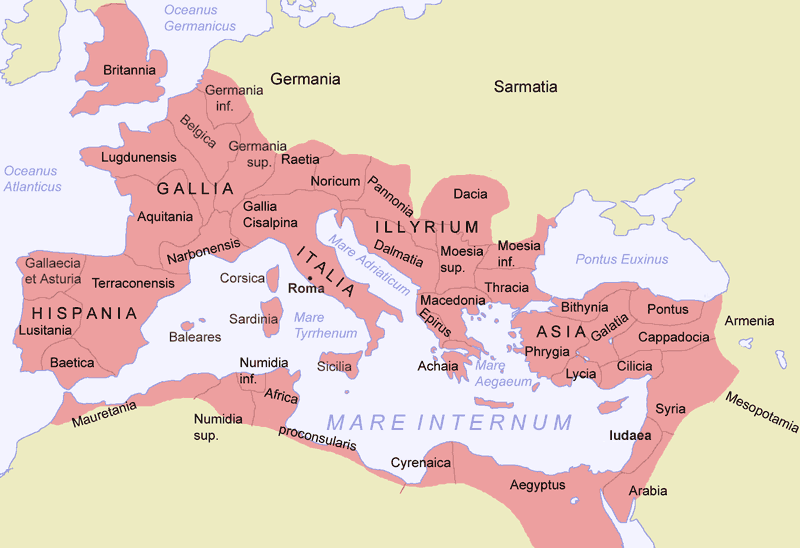The Pax Romana
 •
by
•
by S E B A S T l A N

The Pax Romana began with the accession of Augustus in 27 BC, which marked the end of the Roman Republic and its final civil wars, and lasted until 180 AD at the death of Marcus Aurelius. The Latin word pax, most often translated "peace," also means "treaty" or "accord." The Roman legal system, which forms the basis of many Western court systems today, unified the administration of justice in the courts throughout the provinces. The Legions patrolled the borders with success, and though there were still many foreign wars, the internal empire was free from major invasion, piracy, or social disorder on any grand scale. The empire, wracked with civil war for the last century of the Republic and for years following the Pax Romana, was largely free of large-scale power disputes. Only the year 69 AD, the so-called 'Year of the Four Emperors' following the fall of Nero and the Julio-Claudian line, interrupted nearly 200 years of civil order. Even this was only a minor hiccup in comparison to other eras. The arts and architecture flourished as well, along with commerce and the economy.
The concept of Pax Romana was first described by Edward Gibbon in Chapter Two of The Decline and Fall of the Roman Empire. Gibbon proposed a period of moderation under Augustus and his successors and argued that generals bent on expansion (e.g. Germanicus, Agricola and Corbulo) were checked and recalled by the Emperors during their victories favouring consolidation ahead of further expansion. Gibbon lists the Roman conquest of Britain under Claudius and the conquests of Trajan as exceptions to this policy of moderation and places the end of the period at the death of Marcus Aurelius in 180 AD, despite the conclusion of peace by the latter's son Commodus later in the same year. During the Pax Romana, the area of Roman rule expanded to about five million square kilometres (two million square miles).
Pax Romana, according to Gibbon, would have ended with Commodus himself, whose dispendious excesses and despotic misrule destabilised central Roman politics amidst the chaos of the Germanic invasions of the Rhine-Danube frontier. Commodus's assassination led to a succession crisis, the so-called Year of the Five Emperors, which culminated in the ascension of a soldier-emperor, Septimius Severus, who, despite giving the Empire a peaceful reign, was accused by Gibbon of catalysing the Crisis of the Third Century, a period of economic, political and military crisis that, together with the Germanic invasions and the rise of the Sassanid Persian Empire in the East, almost led the Empire to collapse.

La Paz romana (en latín, pax romana), llamada también Pax augusta, constituye un largo periodo de paz impuesto por el Imperio romano a los pueblos por él sometidos. La expresión proviene del hecho de que la administración y el sistema legal romanos pacificaron las regiones que anteriormente habían sufrido disputas entre jefes, tribus, reyes o ciudades rivales (por ejemplo, los interminables conflictos entre las ciudades-Estado griegas o tribus galas).
Por supuesto, el estado de paz general se refería solo a las regiones interiores del Imperio, mientras se continuó luchando en las fronteras de éste contra los pueblos asentados en dichas zonas como los germanos y los partos. Fue un período de relativa calma, durante el cual no hubo que hacer frente ni a guerras civiles del calibre de las del siglo I a. C., ni a grandes conflictos con potencias extranjeras, como en las Guerras Púnicas (siglos III y II a. C.).
El primer emperador, Augusto, cerró las puertas del templo de Jano, las cuales solo se abrían en tiempos de guerra, cuando creyó haber vencido a cántabros y astures en el año 24 a. C.. Realmente esta guerra se prolongaría hasta el 19 a. C., pero se suele aceptar como fecha de inicio de la Paz Romana el 29 a. C., cuando Augusto proclama oficialmente el final de las guerras civiles, extendiéndose hasta la muerte del emperador Marco Aurelio en el año 180 d.C.).
Se considera que la Paz Romana alcanzó su apogeo durante la dinastía de los Antoninos (96-192 d.C.), marcando una edad dorada que sería recordada de manera nostálgica en los turbulentos siglos posteriores en Occidente. El Imperio alcanzó su máxima extensión en el siglo II, abarcando desde el océano Atlántico en el Oeste hasta el río Tigris en el Este. El comercio se vio favorecido por las cada vez más seguras rutas de comunicación, lo que motivó el bienestar económico imperial. Esta prosperidad se vio reflejada en las ciudades, que se embellecieron y asentaron en detrimento del campo como centros de romanización y de cultura.
La Paz Romana se considera finalizada frente a los grandes disturbios y guerras del siglo III, el cual se caracterizó por una interminable serie de guerras civiles entre varios aspirantes al trono imperial, mientras empeoraba la presión germana y persa en la periferia, llegando a desbordarse periódicamente sobre el Imperio.



Comments
primero, muy bueno
V
muy bueno interesante
V y S muchas gracias 😉
Suscrito y votado.
PROYECTO UNA MM PARA TODOS Y TODAS!
http://www.erepublik.com/es/article/-proyecto-colectivo-una-media-mogul-para-cada-eargentino-segunda-vuelta--2148502/1/20
Caleidoscopios
Mi diario:
http://www.erepublik.com/en/newspaper/caleidoscopios-265170/1
S 1063 PROYECTO UNA MM PARA TODOS Y TODAS!!! PASATE POR EL MIO POR FA!
http://www.erepublik.com/es/newspaper/el-rincon-juninense-278647/1
S 1064
Pasate por el mío..
Somos el ERA!
http://www.erepublik.com/es/article/somo-el-era--2158921/1/20
.O7
/║
/°\